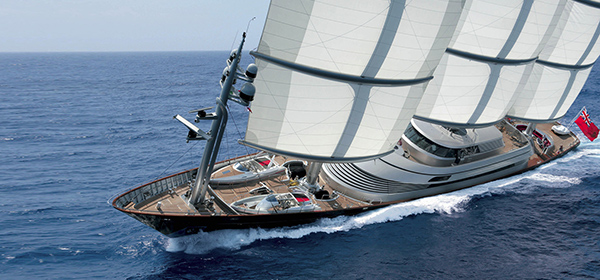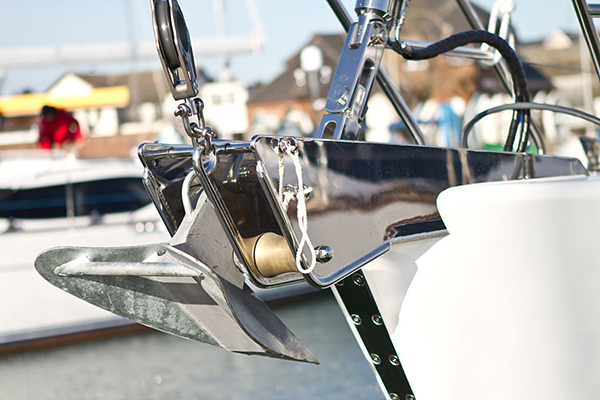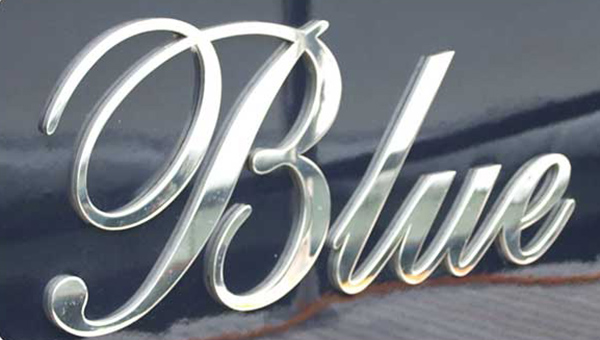The nitty-gritty of yacht fixtures and accessories and how modern techniques are improving their appearance and lifespan.
The metals most commonly used today in the construction of yachts, marine structures and chandlery are stainless steel and aluminium.
While aluminium is light, it has limited corrosion resistance in seawater and requires significant maintenance. Stainless steel, however, is recognised as one of the best materials for marine applications as its corrosion resistance is excellent. It is also a strong and stiff metal and can be given many different eye-catching finishes to make it last even longer.

The Maltese Falcon, designed by Ken Freivokh
Although a chandlery is now a well known term for a shop selling boating parts and supplies, in medieval times it was a room in a house where the candles were stored and the man who looked after them was a chandler. As the 18th century dawned, chandlers were by then selling candles and soap but, grabbing a business opportunity, gradually started selling more general items. Eventually they began a nautical line supplying to shipping and boating stores. As the business changed the word “chandlery” then came to be associated with all things nautical.

Stainless steel yacht fittings
For many boating applications grade 304 stainless steel fittings have been robust enough. Generally, only the 300 series of stainless steel alloys are suitable for sea and salt onslaught. However the bar has been raised if you like and the current industry standard, is grade 316 – (known as “marine grade” stainless) which is a good choice for around 90% of marine uses.
The issue of corrosion will always rear its rusty head – simply enough, if you mix different metals and add salt water, it will happen. An important type of corrosion, which is a concern for boating matters, is being attacked by various chemicals. In general, metals form oxides to protect themselves. However there are differences; whether the oxide forms a hard self-repairing film, which happens with stainless, aluminium and yellow metals, or as in steel, it flakes off to expose fresh metal. The results can range from merely looking shabby if bronze or galvanised deck fittings become worn and rusty, to dangerous if nail sickness occurs and fixtures work loose.
This is why the application of a protective coating can make all the difference whether it is by galvanising (adding a zinc layer) or using the latest PVD (physical vapour deposition) technology. In the case of PVD coatings they serve a double function on yacht chandlery as not only are they suitable for wet and salty conditions they extend the life of the product and also reduce friction.
Therefore PVD coatings are proving invaluable on yacht fittings. First of all the coatings can provide an extremely attractive finish in different colours, which is highly suited to the luxury appeal of a yacht, but also they are extremely resistant to finger printing, grease and other deposits which means a lot less time spent polishing.
In fact the list of boating fixtures that can be coated is endless including, bow and navigation light housings mounts, outriggers, bow rails and cleats, bimini top frames, steering wheels, boat anchors, anchor rollers and pulpits, fuel and water deck caps, drains, all brass work, copper, aluminium, and stainless steel fixtures and more.
A small investment made in a metal coating is beneficial in the long run. It will help maintain the value of an expensive boat, yacht, trawler etc by keeping it rust and scratch-free for years to come.
PVD coatings are also, increasingly, the coating of choice for illuminated letterings or signs which are affixed to the side of yachts. This illuminated lettering continues to radiate due to the metal coating acting as a barrier against the very worst nature can throw at it.

Boat lettering in polished stainless steel
Another technique, shot peening, has blasted its way into the forefront for a wide variety of engineered parts to steel boat hulls. This kind of treatment increases fatigue strength prevents cracking due to wear, corrosion and stress. Shot peening can also enhance lubricity by creating small pores in which oily substances can accumulate. It also creates a uniformly textured, finished surface which can be used ‘naked’ or finished with paint and coatings. Corrosion is not always visible. Sub-surface corrosion is particularly common in areas on yachts directly surrounding metal fasteners, screws, etc. Search peening is a technique in which small, problem areas are peened, and the hidden corrosion is exposed and removed. Search peening is often a better choice compared to many other rust-busting methods because it actually strengthens the metal while getting rid of the corrosion.